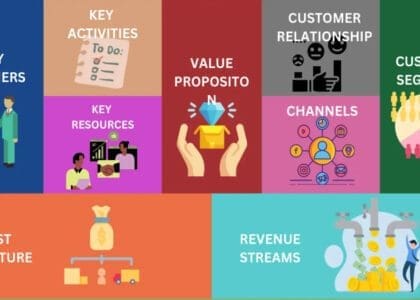The Business Model Canvas (BMC) is a revolutionary strategic tool that enables entrepreneurs and businesses to visualize, assess, and refine their business models efficiently. Unlike traditional business plans, which can be cumbersome and time-consuming, the BMC presents a simplified yet comprehensive framework that covers the essential components of a business. By mapping out key elements such as revenue streams, customer relationships, and cost structures, businesses can optimize their operations and enhance decision-making processes.
Entrepreneurs leverage the BMC to pinpoint strengths, identify weaknesses, and uncover new opportunities for sustainable growth. This model is particularly effective for startups and small businesses that require a dynamic approach to strategic planning. The BMC enhances adaptability, helping businesses remain competitive in an ever-changing market environment.
Understanding the Business Model Canvas
The BMC serves as a dynamic blueprint for structuring and executing business strategies. Its major advantages include:
- Breaking down complex business ideas into easily understandable components.
- Enhancing strategic flexibility by enabling quick adjustments in response to market fluctuations.
- Fostering innovation by allowing entrepreneurs to experiment with different business models and value propositions.
- Promoting internal collaboration by ensuring all stakeholders align with the business vision.
By implementing the BMC, companies gain a clearer perspective of their business architecture, enabling data-driven decision-making and streamlined operations.
Key Elements of the Business Model Canvas
The BMC is composed of nine essential building blocks that collectively define a business’s framework:
- Customer Segments: Identifying target audiences, understanding demographics, and categorizing consumer needs.
- Value Propositions: Establishing what differentiates the business from competitors and how it delivers value to customers.
- Channels: Outlining the pathways through which the business interacts with its customer base, including online platforms, retail stores, and distribution networks.
- Customer Relationships: Determining strategies to foster engagement, retain customers, and build brand loyalty.
- Revenue Streams: Defining the pricing strategies, payment models, and income sources that sustain the business.
- Key Resources: Identifying critical assets such as intellectual property, financial capital, and skilled labor.
- Key Activities: Specifying core business functions necessary to maintain operations, including production, marketing, and customer service.
- Key Partnerships: Leveraging external alliances to enhance efficiency, innovation, and resource-sharing.
- Cost Structure: Managing financial expenses efficiently to maximize profitability and sustainability.
Mastering these nine elements is crucial for building a scalable and profitable business model.
How to Use the Business Model Canvas Effectively
To derive maximum benefits from the BMC, businesses should follow these best practices:
- Systematically complete each section to ensure clarity and precision in business planning.
- Utilize real-time data and insights to populate the canvas with accurate information.
- Engage teams in brainstorming sessions to foster collective input and strategic alignment.
- Regularly update the BMC to reflect shifts in market trends, customer preferences, and business objectives.
One of the most compelling examples of BMC implementation is Google’s approach to structuring its business model. By continuously adapting its revenue streams and value propositions, Google remains a leader in the tech industry.
Business Model Canvas Examples
Several industry giants have successfully applied the BMC to drive innovation and scalability:
- Airbnb: Focused on leveraging digital platforms to connect travelers with unique lodging experiences.
- Amazon: Integrated logistics, supply chain management, and cloud computing to optimize efficiency.
- Tesla: Pioneered sustainable energy solutions through technological innovation and strategic partnerships.
Case studies reveal how both startups and established corporations use the BMC as a framework to navigate business complexities and drive long-term growth.
Business Model Canvas vs. Traditional Business Plans
The BMC differs from traditional business plans in several ways:
- Agility and Adaptability: BMC allows businesses to pivot quickly, whereas traditional plans often require time-consuming revisions.
- Visual Representation: Unlike lengthy business plans, BMC offers a clear, easy-to-digest framework.
- Strategic Versatility: BMC supports iterative development and real-time modifications.
Choosing the appropriate approach depends on business objectives, target audience, and industry requirements.
Adapting and Evolving Your Business Model
Businesses must continuously refine their BMC to remain competitive:
- Assess market shifts and emerging trends to keep value propositions relevant.
- Analyze customer feedback to enhance product offerings and service quality.
- Innovate proactively by exploring new partnerships, revenue streams, and operational efficiencies.
Integrating socially responsible business models further strengthens market positioning and fosters sustainable growth.
Common Mistakes to Avoid When Using the Business Model Canvas
- Overgeneralizing customer segments: Not segmenting customers effectively can lead to weak targeting.
- Lack of strategic focus: Failing to align business activities with clear objectives can dilute effectiveness.
- Ignoring financial viability: Underestimating cost structures and revenue streams can jeopardize sustainability.
- Infrequent updates: A static BMC loses relevance in rapidly evolving industries.
To prevent these pitfalls, businesses must ensure that their BMC is well-researched, detailed, and consistently updated.
Conclusion
The Business Model Canvas remains an indispensable tool for businesses aiming to refine their strategic framework, optimize operational efficiency, and drive sustainable growth. Entrepreneurs and business leaders should leverage the BMC to align their vision with actionable strategies. When used effectively, the BMC fosters innovation, enhances competitive advantage, and ensures long-term success in a dynamic business landscape.
References
- The Effect of Utilizing Business Model Canvas on the Satisfaction of Operating Electronic Business. AvailableHere
- An Application of the Business Model Canvas. Available Here
- The Business Model Canvas. Available Here
- Business Model Canvas (BMC) as a Tool of Planning and Implementing Entrepreneurial Projects: A Case Study of GOOGLE Business Model Canvas. Available Here
- The Effect of Utilizing Business Model Canvas on the Satisfaction of Operating Electronic Business. AvailableHere
- Towards a New Business Model Canvas for Platform Businesses in Two-Sided Markets. Available Here
- The Case for a Socially Oriented Business Model Canvas. Available Here
- Business Model Canvas Should Pay More Attention to the Software Startup Team. Available Here
- Business Model Canvas in Global Enterprises. Available Here


